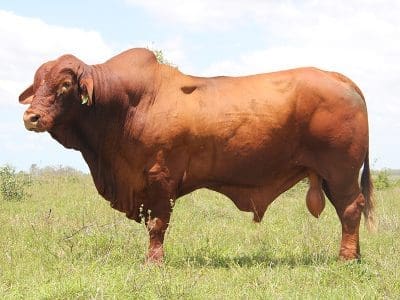A recent Beef Central genetics article about a multi-nation research study flagging the ‘feasibility’ of breeding strong tick resistance into all cattle breeds has attracted a response from one of Australia’s pioneers of cattle selection for tick resistance.
The study (click here to read original article) indicated that cattle tick may be much more effectively managed, or even eradicated if resistance is selected for in cattle.

Droughtmaster bull on Lisgar, south of Home Hill
The study demonstrated proof-of-concept for using the cattle genome to tackle cattle tick – a parasite that costs the Australian cattle industry more than $175 million each year.
Now retired near Tewantin on Queensland’s Sunshine Coast, former North Queensland beef extension leader and QDPI beef cattle husbandry branch special projects manager John Round contacted Beef Central to remind us of important tick selection work that has been ongoing in North Queensland since the mid-1970s.
“I read the original article with interest,” Mr Round said.
“However it seems to imply that the possibility for genetic selection for cattle tick resistance is new knowledge.”
Acting on knowledge of the heritability of tick resistance in Bos Indicus cattle, a group of officers with the then Queensland Department of Primary Industries in North Queensland – including Mr Round – initiated a series of projects from the mid-1970s in the Ingham, Home Hill and Bowen districts to demonstrate the effectiveness of selection for the trait.
“At Ingham and Home hill, Droughtmaster cattle were involved, and at Bowen, higher grade Brahmans,” Mr Round said.
“It is now the case that there are properties in North Queensland that have applied selectin pressure for tick resistance that have not needed to use chemicals for tick control for many years,” he said.
“In particular, Eddie Rea and family’s property, Lisgar, south of Home Hill, has been monitored continually, and is now in the position that cattle dipping facilities have not been used for tick control in about 40 years.”
A major feature at Lisgar was that in addition to the advantage of gaining tick control, other selection factors such as selection for reproduction and growth rates had resulted in dramatic improvements in property productivity, Mr Round said.
“It is gratifying to learn that the project outlined by Dr Burrow in the original article has shown that the basic processes commenced many years previously have been proven sound. It is to be hoped that having the process proven by the large organisation will lead to wider publicity and much greater adoption by industry,” he said.
“The potential for substantial reduction in chemical use and resistance development is a highly desirable attribute for the beef production industry.”

Nguni cattle -Bos Taurus Africanus performs well in tick areas . In Bowen area and numerous other areas. Survived in some of the worst tick ridden areas in Southern Africa for centuries.
Natural selected
Thanks for your comment, Edwin. There was very small importations of Nguni into Australia in the 1990s, along with Boran and Tuli. Despite their good fertility and tick resistance, they failed to get any traction, primarily because of their moderate frame score and light bone. Editor